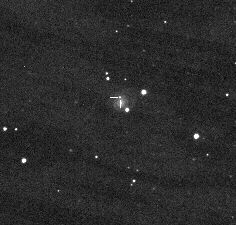SN2014ec (ex PSN J11023520+5035094) (RA 11h02m35.20s - DEC +50°35'09.4") discovered on November 20th 2014 in the galaxy UGC6109 (offset 2E 13N) magnitude 17.1 Type II (z=0.0223).
SN discoveres: F. Ciabattari, E.Mazzoni, M.Rossi, P.Campaner (Newton 20" - Monte Agliale Observatory - Lucca, Italy).

CLASSIFICATION ATEL
==============================================================================
ATEL #6750 ATEL #6750
Title: Asiago spectroscopic classification of six supernovae
Author: P. Ochner, S. Benetti, A. Pastorello, L. Tomasella, E. Cappellaro,
N. Elias-Rosa, L. Tartaglia, G. Terreran, M. Turatto (INAF Osservatorio
Astronomico di Padova)
Queries:
Questo indirizzo e-mail è protetto dallo spam bot. Abilita Javascript per vederlo.
Posted: 25 Nov 2014; 14:48 UT
Subjects:Optical, Supernovae
The Asiago Transient Classification Program (Tomasella et al. 2014, AN,
335, 841) reports the spectroscopic classification
of the following transients. Targets were supplied by the Gaia Photometric
Science Alerts programme and by the CBAT Transient Objects Confirmation
Page (TOCP).
The observations were performed with the Asiago 1.82 m Copernico Telescope
(+AFOSC; range 340-820 nm; resolution 1.2 nm).
Name | Date (UT) | z | Type | Phase
| Notes
PSN J01510872+3155218 | 20141124.81 | 0.26 | SLSNII ? |
| (1)
PSN J07591099+3254392 | 20141124.94 | 0.0174 | IIn | 2 weeks
| (2)
PSN J11023520+5035094 | 20141124.97 | 0.0223 | II | 10 days
| (3)
Gaia14adb | 20141125.10 | 0.053 | Ia | +20d
| (4)
Gaia14adf | 20141125.12 | 0.06 | II | 2 weeks
| (5)
Gaia14adg | 20141125.14 | 0.154 | II | around
max | (6)
(1) The spectrum shows a blue continuum and broad features which can be
consistent with Balmer lines (Hbeta and Hgamma), with superimposed narrow
unresolved components. Narrow [OIII] lines are also detected. Accounting
for the very luminous absolute mag of the transient (M~-22.6), the transient
is consistent with both a SLSNII and an AGN.
The redshift of the host galaxy SDSS J015108.70+315520.6, as derived from
narrow emissions, is in fair agreement with its photometric redshift (z=0.241).
(2) Heliocentric radial velocity of the host galaxy UGC 4132 from de Vaucouleurs
et al. 1991 RC3.9 via NED.
(3) Heliocentric radial velocity of the host galaxy UGC 6109 from Falco
et al. 1999 PASP 111, 438 via NED. UGC 6109 is the same host galaxy as
for SN 2007rt.
(4) The transient is close to SDSS galaxy SDSS J120512.03+215018.1, with
photometric redshift z=0.05. The spectrum shows this is
a type-Ia SN about 2 weeks after the maximum light. An expansion velocity
of 9500 km/s is derived from the position of the minimum of the Si II 635.5-nm
line.
(5) The transient is close to SDSS J120929.60+200613.3, with photometric
redshift z=0.076.
(6) The transient is close to SDSS J115032.78-020617.0, with photometric
redshift z=0.167.
Classification was done with GELATO (Harutyunyan et al. 2008, A&A, 488,
383) and SNID (Blondin and Tonry 2007, ApJ, 666, 1024).
The Asiago classification spectra are posted at the website http://sngroup.oapd.inaf.it.
We acknowledge, for the Gaia transients, ESA Gaia (http://cosmos.esa.int/gaia),
and the DPAC Photometric Science Alerts Team (http://gaia.ac.uk/selected-gaia-science-alerts)
(Rixon et al, 2014, ATel #6593).
Padova Asiago SN group: http://sngroup.oapd.inaf.it
------------------------------------------------------------------------------
==============================================================================




